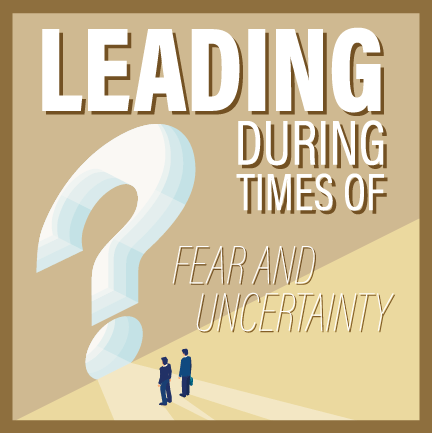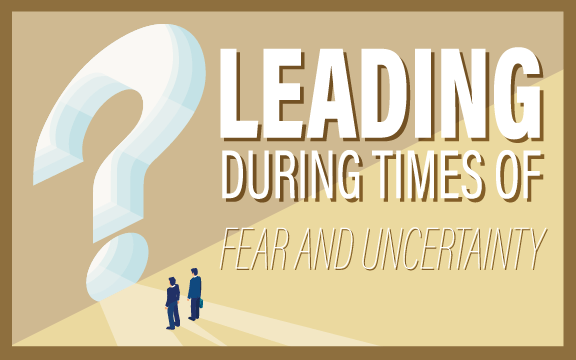Author: Dr. Pete Hammett, Visiting Professor
It has been said that the only thing constant is change. If that’s so, then it’s equally true that there are times when fear greases the bearings in the wheels of change. While fear turned inward will result in paralyzing inaction, fear turned outward can serve as a catalyst for inspiration and innovation. Theories that encourage “courageous leadership” and “leading fearlessly” focus on behaviors that attempt to conquer fear. A more effective, pragmatic response would be for leaders to understand how to acknowledge fear and lead effectively during times of uncertainty.
 Given the remarkable uncertainties that lie ahead, what we need first and foremost are leaders of character. Now, perhaps more than in recent memory, we need leaders with the capability to communicate clearly and connect empathically with those they lead.
Given the remarkable uncertainties that lie ahead, what we need first and foremost are leaders of character. Now, perhaps more than in recent memory, we need leaders with the capability to communicate clearly and connect empathically with those they lead.
Leading in Troubled Times: The Importance of Character
Until recently, the impact of the coronavirus (COVID-19) was simply something many of us witnessed being reported on the evening news. But in a matter of a few weeks, nearly every person on the face of the planet has now been impacted by COVID-19. Now, our attention is hyper-focused on our political, business and civic leaders.
Throughout my career, I’ve had the honor of speaking across the country on various leadership topics. During these events, I often ask audiences what they see as pressing challenges for leaders. From these conversations, I have learned that it is critical for leaders to act according to where they want their organization to be in the future, rather than how their organization is at the given moment. In other words, it is important to work ON your business instead of solely IN it. But now a new question has surfaced: how should we be leading during this time of uncertainty?
Communicate Honestly
A few years ago, I was engaged in a major change effort in a Midwest power company. At the beginning of the effort, we struggled with how to communicate to impacted employees. In the mist of this challenge, I was conducting an employee town-hall when someone offered this thought: “We can deal with change; it’s uncertainty that drives us crazy.” Often, people are more anxious about the prospect of what might happen than they are about what has already occurred. During these times, regular communication becomes essential. Even unpleasant information can help bring a sense of closure of the unknown. In times of uncertainty, honest communications is vital. Even if you are uncertain or only have partial answers, let people know where you are, what you do know and what is still to be determined because if you don’t fill in the information gap, your people will.
If nature abhors a vacuum, then our brain hates a mystery. While some people say they love mysteries, what they may really mean to say is that they love solving them. No one likes an unsolved problem or unanswered question. Consider this — many employees have been trained and are skilled in drawing on limited sources of data from which to base calculated business conclusions. It should be no surprise that in the absence of effective communications, people will develop their own conclusions, often drawing on rumors and speculations. In this light, it is important to understand it is equally effective to communicate what is unknown as it is to communicate what is known. Leaders often delay communicating with their teams because no decision or course of action has been made, but simply communicating a decision still under review is more effective than leaving employees guessing. Likewise, remember that communication is as much about listening as it is speaking. Giving people the opportunity to express their concern can help leaders better understand where worry is coming from, and perhaps, lead more effectively.
Finally, don’t sugarcoat bad news or shy away from acknowledging your own apprehensions. I remember when my brother-in-law had to take my nephew in for his immunization shots. As the nurse prepared to administer the shot, my nephew innocently asked, “Will this hurt?” I imagine the nurse likely received this question quite often, so I’m not critical with her answer of, “No, it doesn’t hurt really.” But my brother-in-law hugged my nephew and softly said, “This will hurt, but not for long. Be tough and we’ll get something fun on the way home.” The shot came, a few tears fell, and that was it — expect for an ice cream stop on the way home.
Be Visible
Equally important during times of uncertainty is for leaders to be visible, physically connecting to their teams. Leaders should not underestimate the impact their physical presence will have in assuring their people. If the captain of a ship isn’t on deck during a storm, the crew may wonder, “What does the Captain know that I don’t?” This reminds me of a difficult season at American Express where leaders where admonished, “Now is not the time to hunker in your bunker!” Remaining connected is always important, but more so in times of heightened fear.
The story is told of a multinational organization that was facing significant workforce reductions. Specifically, two regional operating centers were impacted. At one location, the division head flew in one morning, brought the employees together, gave them the news and left for corporate within the hour. At the other location, a different division head came to the center, met with employees, shared the news and stayed for two days walking the floors, meeting with people, hearing concerns, answering the questions he could and making it a point to get back on with people on questions he didn’t know. Which center do you think had the most effective transition and maintained the highest service quality during this time of uncertainty?
Some of the most meaningful lessons on leading during times of fear and uncertainty come from the U.S. military. I had the opportunity to observe the 82nd Airborne conduct a night drop. Almost 1,500 soldiers loaded with full packs jumped at night into a field upon which Humvees and artillery had just dropped in. I was standing near the cargo door of a C-130 as soldiers boarded the plane. Overseeing the process was the Jump Master, an African American female who commanded an orderly procession with amazing precision. When I thought it was okay, I asked her the obvious question: “How do you motivate someone to jump out of a perfectly good airplane?”
Her answer stays with me to this day. She said, “One thing you don’t do is become a cheerleader. It’s B.S. to tell someone who is about to leap into open sky, ‘this is an important task so you need to do a good job.’ The paratrooper getting ready to jump knows all too well how important it is for them to do a good job. They don’t need a cheerleader to motivate them. What they need is a leader — someone who will put on a chute and jump with them.” The Jump Master pointed my attention to an officer standing on the tarmac a few yards from us. “You see that guy watching the loading? That’s our commanding officer. Every time we jump, he’s the first one out the door.” She turned back to me and said, “You want to know how we’re motivated to jump? We follow our commander out the door.”
Inspire Confidence with Integrity
As I talk to people throughout the country, I get a sense that most of us are not looking for leaders who are infallible, but instead for leaders who are genuine. We desperately want to believe in our leaders, and a cornerstone in establishing this trust is for leaders to be genuine by acknowledging when fear surfaces and actively, constructively managing the energy associated with this emotion.
Reflecting again on the military; Army leaders are taught to acknowledge that they lead people who, like themselves, have hopes, fears, concerns and dreams. Harnessing this emotional energy is a powerful leadership tool. Unfortunately, we often identify the opposite of fear to be courage. However, the Army Leadership Manual suggests that “courage isn’t the absence of fear; (but) rather, it’s the ability to put fear aside and do what is necessary”. In other words, it is the ability to lead past fear.
This bears repeating…personal courage is not the absence of fear; it is the ability to put fear aside and do what is necessary. It takes two forms: physical and moral. Good leaders demonstrate both. Physical courage is overcoming fears of bodily harm. Moral courage is a willingness to stand firm on values, principles and convictions — to stand up for what you believe to be right, regardless of the consequences.
Making Leadership Real
Whether it stems from uncertainties associated with a downturn in the economy or concerns over the health and well-being of our family and friends, fear is an emotion that easily surfaces in our lives. Rather than try to overcome or work around fear, leaders need to understand that fear — like other emotions such as excitement and enthusiasm — can be harnessed, and its energy can be focused to bring out the best in themselves, their teams and their organizations.
Given the remarkable uncertainties that lie ahead, we need leaders of character, honesty and integrity. Leading through fear is not about ignoring fear any more than courage is about the absence of fear. Effective leaders must have the honesty to acknowledge the anxieties and frustrations that grip us all and the integrity to display genuine confidence in our ability to meet whatever challenges come our way. Equally important are leaders with the capability to communicate clearly and be visible, as it is during times of uncertainty when fear and doubt threaten to overwhelm our senses that we look to our leaders for frequent and clear communication. Most importantly, we look for leaders who are visible — those who get out from behind their desk to stand with their teams.
:




